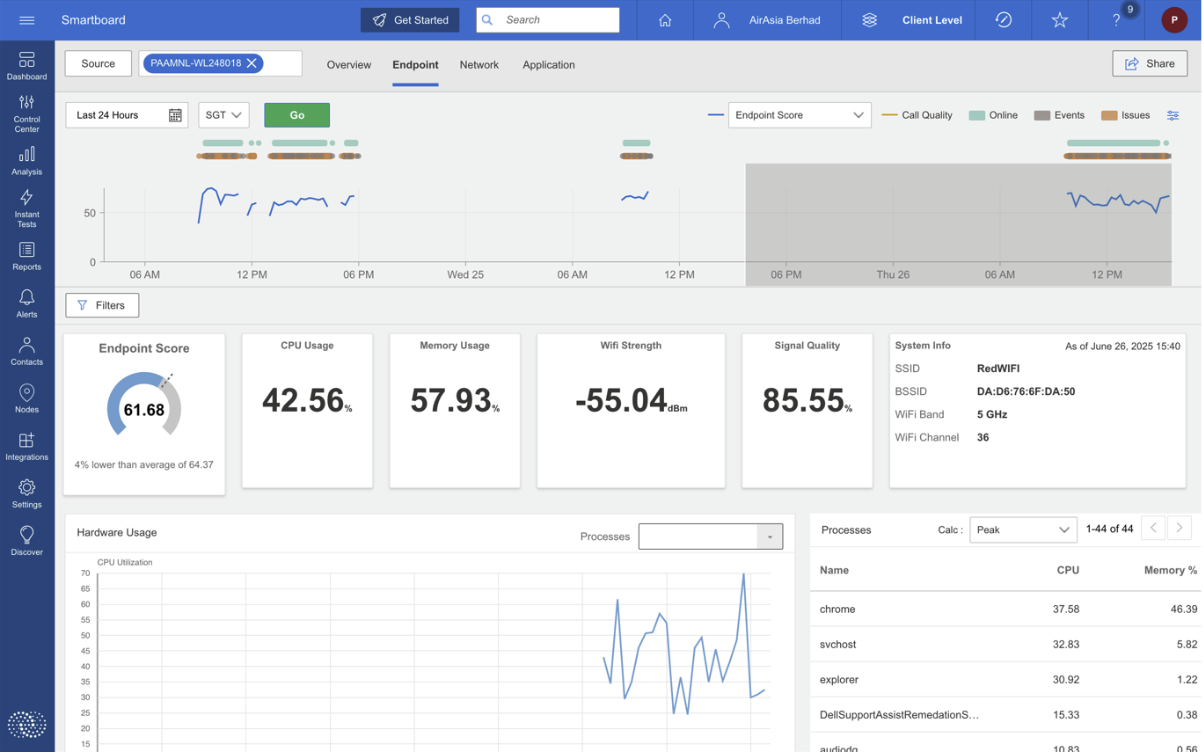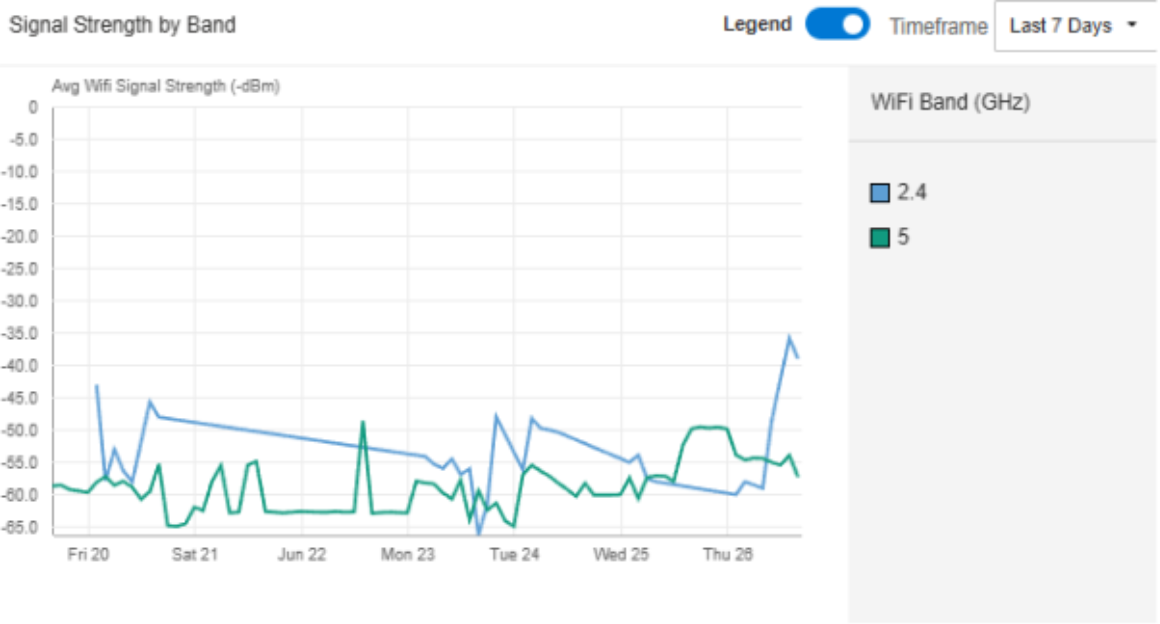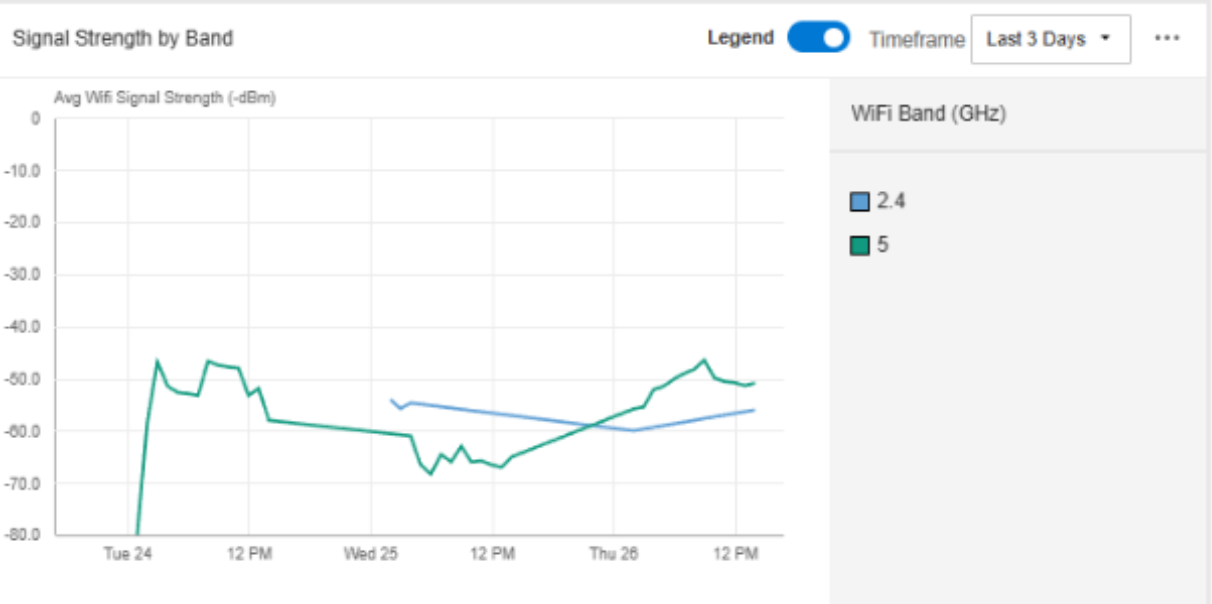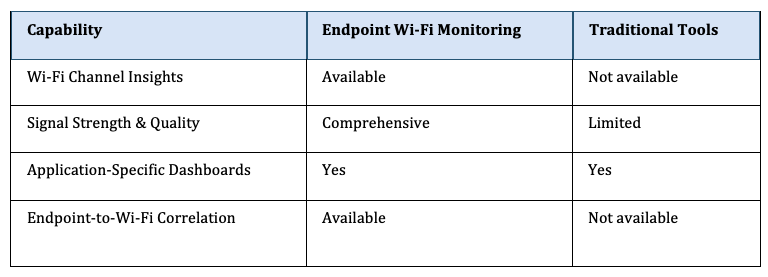Diagnosing Wi-Fi failures that traditional tools miss: a case study
A global airline experienced persistent Google Meet connectivity issues with no apparent network infrastructure faults. While their APM tool offered visibility into network paths, it didn’t surface any local anomalies. Catchpoint’s endpoint monitoring, however, revealed performance degradation specifically on Wi-Fi Channel 44 (5GHz band), where signal strength dropped to -80 dBm compared to optimal ranges of -30 to -50 dBm. This correlation between Wi-Fi channel performance and application response times enabled rapid issue resolution and informed infrastructure optimization decisions.
What problem was the airline facing with Google Meet?
The airline's IT team faced recurring user complaints about Google Meet performance issues, including dropped calls and audio quality degradation. Initial network diagnostics showed no apparent infrastructure problems, leaving the team without actionable insights into the root cause. Tools like Cisco’s Splunk and ThousandEyes lack the local granularity needed to correlate user experience issues with specific Wi-Fi performance characteristics.
The airline’s IT team couldn’t find the root cause using standard tools, leaving user complaints unresolved.
How was endpoint monitoring used to collect Wi-Fi data?
During a proof-of-concept deployment, endpoint agents were installed across multiple machines to collect granular Wi-Fi telemetry including:
- Wi-Fi channel and band information
- Signal strength measurements (dBm)
- Connection quality metrics
- Application-specific response times for Google Meet

Catchpoint’s endpoint telemetry made it possible to directly correlate Wi-Fi performance with user experience—something traditional monitoring tools couldn’t do. By capturing metrics like signal strength and channel usage at the device level, our agents revealed patterns across varying network conditions that would’ve otherwise gone undetected.
What did the Wi-Fi performance data reveal?
Monitoring revealed significant performance variation between Wi-Fi bands.

The 2.4GHz band consistently delivered stronger signal strength than 5GHz, confirming environmental interference with higher frequencies.
- Channel 44 (5GHz band): Exhibited noticeably slower Google Meet response times
- 2.4GHz channels: Demonstrated improved signal strength and reduced user complaints
How did weak Wi-Fi signal strength affect Google Meet?

Signal strength analysis showed critical performance thresholds:
- Excellent range: -30 to -50 dBm
- Weak performance threshold: -70 dBm and below
- Observed minimum: -80 dBm during connectivity issues
A specific user experiencing meeting issues on the 24th recorded signal strength as low as -80 dBm, well below acceptable performance thresholds.
What was the correlation between Wi-Fi signal and app performance?

Direct correlation was established between Wi-Fi signal strength and Google Meet response times. Users on Channel 44 (5GHz) experienced degraded performance that aligned with decreased signal strength measurements.
Why is 5GHz Wi-Fi more vulnerable in office environments?
The data confirmed expected 5GHz Wi-Fi behavior characteristics:
- Shorter range compared to 2.4GHz
- Higher susceptibility to interference
- Performance degradation in environments with physical obstacles
- Reduced effectiveness at distance from access points
In office environments with multiple walls and obstacles between users and access points, these characteristics significantly impact connectivity quality. The shorter range and susceptibility to interference made 5GHz unsuitable for the office’s physical layout, highlighting the need for better infrastructure planning
What business impact did endpoint visibility deliver?
The granular Wi-Fi visibility enabled:
- Proactive issue identification: Problems detected before user complaints
- Rapid root cause analysis: Direct correlation between Wi-Fi conditions and application performance
- Targeted remediation: Specific channel and location-based optimization
- Infrastructure planning: Data-driven access point deployment decisions
How does Catchpoint compare to traditional monitoring tools?

What can IT teams learn from this case?
This case demonstrates the value of endpoint-level Wi-Fi monitoring in enterprise environments where:
- Application performance issues may have infrastructure root causes not visible through traditional monitoring
- Granular Wi-Fi telemetry enables rapid diagnosis of connectivity bottlenecks
- Real-time correlation between Wi-Fi conditions and application performance provides actionable insights for infrastructure optimization
- End-to-end visibility across the entire connectivity stack is essential for effective troubleshooting
What steps should organizations take to prevent similar issues?
Based on these findings, organizations should consider:
- Deploying endpoint monitoring with Wi-Fi-specific telemetry collection
- Establishing signal strength thresholds for proactive alerting
- Implementing access point placement optimization based on actual usage patterns
- Developing correlation dashboards linking Wi-Fi performance to critical application metrics
The systematic approach to Wi-Fi performance analysis demonstrated here provides a framework for identifying and resolving connectivity issues that traditional monitoring approaches may miss.
Ready to uncover the Wi-Fi blind spots impacting your users?
Learn how Catchpoint delivers end-to-end visibility—from endpoint to cloud.



